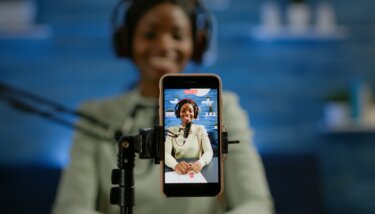Health and fitness creators who want to build their brand, share knowledge worldwide, and control their time can achieve that dream by launching an online fitness business. Using a mobile app makes it even easier to bring that dream to life.
Not sure how fitness app development works? We’ve helped dozens of fitness creators build apps that generate revenue and keep members engaged with active communities. For example, Find What Feels Good saw 201% user growth and 65% of their content consumed through their mobile app.
Keep reading to discover how to build your app, what it might cost, and ways to make it profitable — everything you need to bring your fitness idea to life.
How to create a fitness app
With the fitness app market expected to reach $10 billion by 2029, now is a great time to create your own. Here are the key steps and strategies to help you develop and grow a successful app.
1. Decide what kind of fitness app you’ll build
There are many types of fitness apps, so it’s important to think intentionally about your goals from the start.
You can provide real-time coaching, share live or pre-recorded workouts, or deliver interactive sessions through a live streaming platform. Some apps help users track their nutritional intake. Others help users track and improve their sleep, mental health, or take a comprehensive approach to all of the above.
Knowing your focus early will shape every stage of development. A nutritional app may need access to an external API and nutritional database, for example, while a Pilates app might benefit more from direct communication with the instructor. Addressing these points early on will help you build a strong foundation for your app.
For the following examples, we’ll focus on a video-based workout app that includes both live and recorded workouts along with community engagement features. However, these insights are relevant to nearly any type of fitness app.
2. Pick where your app will be available
While you’re thinking about the type of fitness app you’d like to build, remember that there are lots of places you can make that app available. Remember that you’re not just limited to mobile apps!
Smart TV apps, for example, are popular among fitness creators because they get your workouts right into your users’ living rooms. If you’re interested in smart TV app development, make sure to optimize your app for the platform. Common options include:
Traditional mobile apps are also important. Many fitness creators build an iOS video streaming app first due to Apple’s device popularity. With the right platform, developing an Android streaming app alongside it is typically straightforward.
And don’t forget other mobile devices; some of our fitness creators have even used Uscreen to create Apple Watch fitness apps.
3. Focus on your niche
Before you launch, take a moment to identify your video content niche. Look at your audience, social media followers, or the group of people who respond most to your content. Ask yourself: Who benefits most from what I offer? Narrowing your focus helps you stand out in a crowded market.
Targeting a small niche is an effective way to differentiate your online fitness business. “Busy professionals” is a huge category, and there’s a ton of competition. If you have a strong social media following, you’ve probably already done a good job of differentiating.
For our video workout app, we might sell online fitness programs to people who want to do Pilates in their hotel room while they travel or families who work out together. These are easier niches to get established in.
When launching your app, keep your focus on your specific niche. A group you’ve served well in the past will be your best customers when you launch your mobile or smart TV app.
Fittest Core is a great example — Macy Pruett launched her fitness business to help pre- and postpartum moms work out safety and confidently. This audience wasn’t being sufficiently served, and Pruett was able to step in and launch a successful membership community by providing online fitness content that met their needs.
When you’re thinking about expanding by launching an app, don’t lose sight of what made your fitness content successful in the first place. You may be able to expand later, but staying focused while you’re launching your app will help you build an audience.
4. Create your fitness content
The type of app you’re creating will determine what “content” means for this step. In the case of our video-based workout app, it’s workout videos, which will need to be recorded and edited.
For a nutritional app, it might be the nutritional facts you get from an external database, so you’ll need to make sure that connection is working. Another fitness app might require lots of written content.
Unless you already have a large library of content, start building your fitness content library early.
But you may not need as much content as you think. Our customers who run fitness streaming sites and apps typically average around 15 hours of video. The key is to have enough content at launch to make it worthwhile for users to subscribe.
It’s also possible to create content in real time. M/BODY, an online fitness studio, films 95% of its content live, then uses Uscreen to automatically upload the recorded videos that can be viewed later.
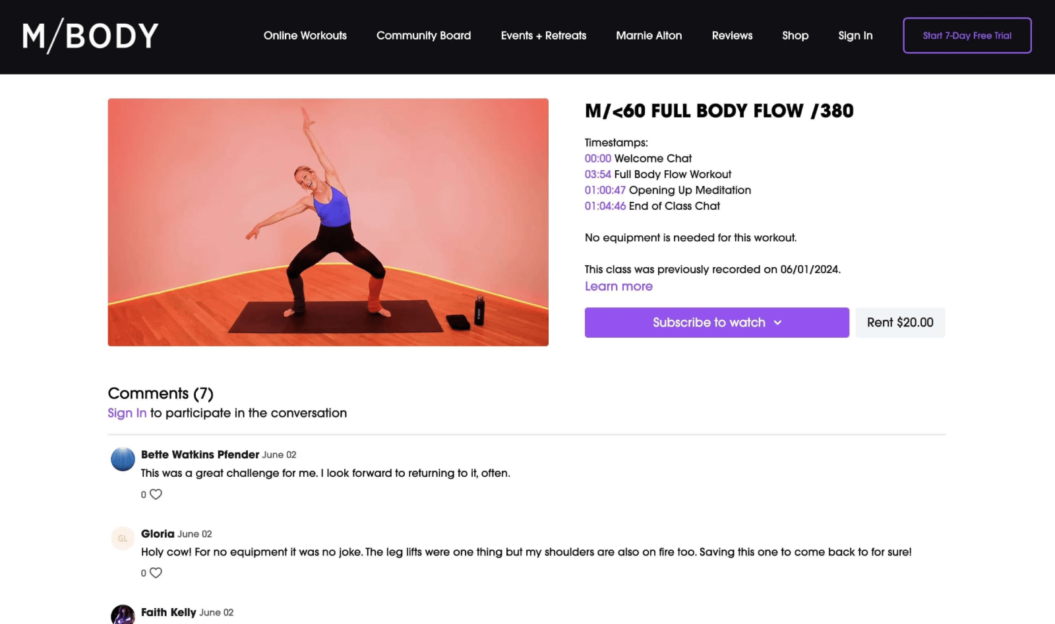
This emphasis on live classes combined with flexible monetization and a dedicated community have helped M/BODY pull in $40,000 per month.
5. Decide on a monetization model
How you plan on monetizing your app may determine how you build it and what fitness app features you want to include.
There are several ways you can monetize your app. They focus on video-based workout apps and communities, but you can apply similar principles to other types of fitness apps:
- Subscription video on demand: Users pay a regular fee (usually monthly or annually) to get access to your videos. They might get access to everything, or you may have tiered subscription options that give access to different sets of videos.
- Transactional video on demand: Users pay to rent or buy access to a video, a set of videos, or an entire course.
- One-time fee: Users pay once and get access to everything the app offers forever.
- Community-only access: Depending on how our video app provides value and what people want from it, it’s possible to offer access to the community as a standalone membership option.
- Hybrid approach: Combine any of the methods above. You could, for example, offer a membership that provides unlimited access but also allows users to rent a single video.
Power Nation Fitness‘ three-tiered membership options provide a great example of flexible monetization::
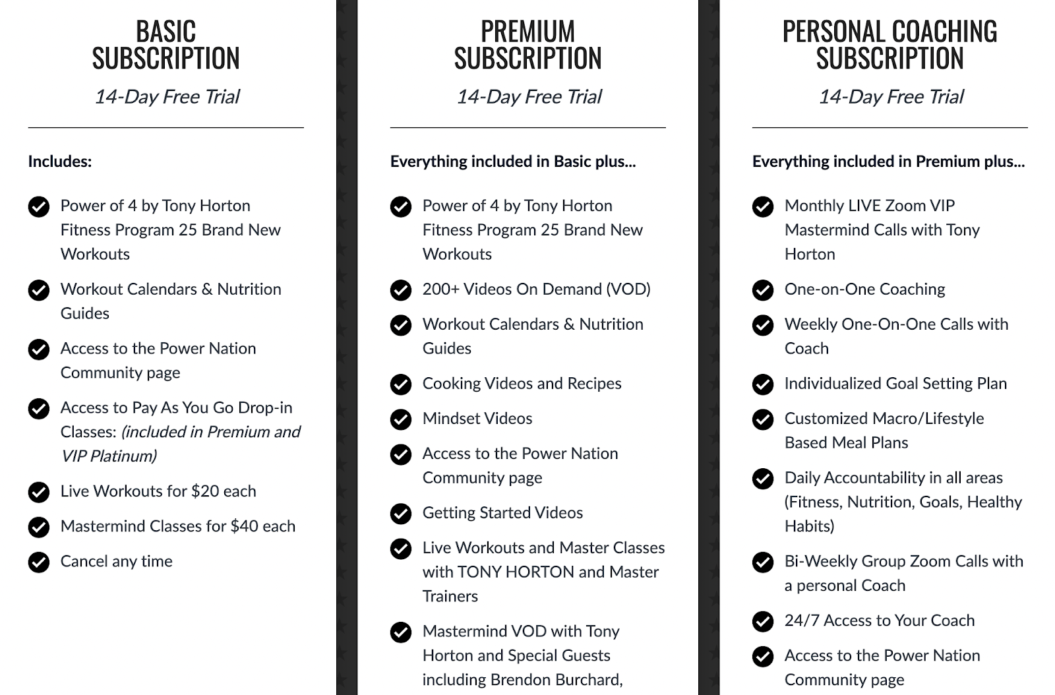
New members can clearly see the different levels of access in each tier and can choose the one that works best for them.
6. Figure out how you’ll build your app
There are three ways you can go about developing a fitness app: Partner with a no-code platform, build it from scratch yourself, or hire an agency. Here’s a quick breakdown of each:
| Option | Best for | Pros | Cons |
| No-code platform | Creators who want to launch quickly with minimal technical skills | Platform handles the buildEasy to create content libraries and live streamsCan expand to Apple Watch, Roku, Samsung TV, etc. | Moderate cost, typically a couple hundred dollars/month |
| Code from scratch | Creators with technical expertise seeking full control | Complete control over every featureUseful for complex integrations | Free aside from hosting/APIsRequires time and programming knowledge |
| Hire a developer or agency | Creators with complex ideas and/or large budgets | Fully customized appProfessional-grade featuresCan implement complex functionality | High cost, often $20,000+Not realistic for most creators |
Creating a fitness app with a no-code platform
Best for: Creators who want to launch quickly with minimal technical skills
When you partner with a platform to build a fitness app, the platform takes care of all of the technical aspects. You’ll choose your brand colors, upload logos, and make some design decisions, but the actual building of the app will be taken care of for you.
This is especially useful for creators aiming to launch video-based apps, since many over-the-top (OTT) app builders can help you get up and running. They make it simple to organize a content library, live stream workouts, and provide remote coaching to your audience.
It’s also a great choice if you want to go beyond iPhone and Android apps. For instance, our workout video business could create an Apple Watch app or release apps for Roku and Samsung, allowing users to access our videos on their smart TVs.
Partnering with a no-code platform is right in the middle when it comes to cost, and you can plan on spending a couple of hundred dollars a month, depending on the platform you choose and which features you’re looking for.
Code up a fitness app from scratch
Best for: Creators with technical expertise seeking full control
If you have experience building apps, you may be tempted to build one yourself. While this isn’t the best option for most creators, many will appreciate the fact that they have complete control over every aspect of their app.
This may also be an appealing option if you’re building an app that needs complex integrations. A sleep tracker, for example, may need to access a phone’s accelerometer and microphone to analyze sleep patterns.
One big advantage of coding up an app yourself is that it’s completely free. You’ll pay to use APIs or host content, but the app itself won’t cost you a dime. That being said, it’ll take some time to build it, and you’ll need to be familiar with the programming languages used by the platforms you’re interested in.
Hire a developer for your fitness app
Best for: Creators with complex ideas and/or large budgets
Does your fitness app idea include some very complex functionality? Do you have tens of thousands of dollars to invest in your idea? If you answered yes to either of these questions, working with a developer or an agency might be the right option.
Hiring an experienced fitness app developer gives you access to a wealth of technical expertise, letting you build absolutely whatever you want. If you dream of building an app that provides customized recommendations based on exercise, nutrition, and sleep, you may need to hire someone who can program something very complicated.
Working with a developer or an agency has a lot of benefits, but you’ll pay for them. Building a custom app could cost upwards of $20,000 and there’s no ceiling. You’ll get a pro-level, completely customized app, but this price tag isn’t realistic for most creators.
7. Launch your app and start building your community
Once your app is built (which could take 30 days with a no-code platform or over six months with complex development from an agency), it’s time to get it in front of your audience. After it’s on the app store, your primary task will be marketing your fitness app.
Here are a few ways fitness creators have found success in marketing their apps:
Maximize social media
If you have a social media following or consistently share your content online, you already have an audience that appreciates and engages with your work. Tell them about your app regularly and make sure they know they can get more of the content that they love.
Uscreen customer Find What Feels Good is a great example. While the popular YouTube channel Yoga With Adriene has over 13 million subscribers, Adriene Mishler and her business partner Chris Sharpe wanted to offer an app-based experience with a content library and more advanced yoga offerings.
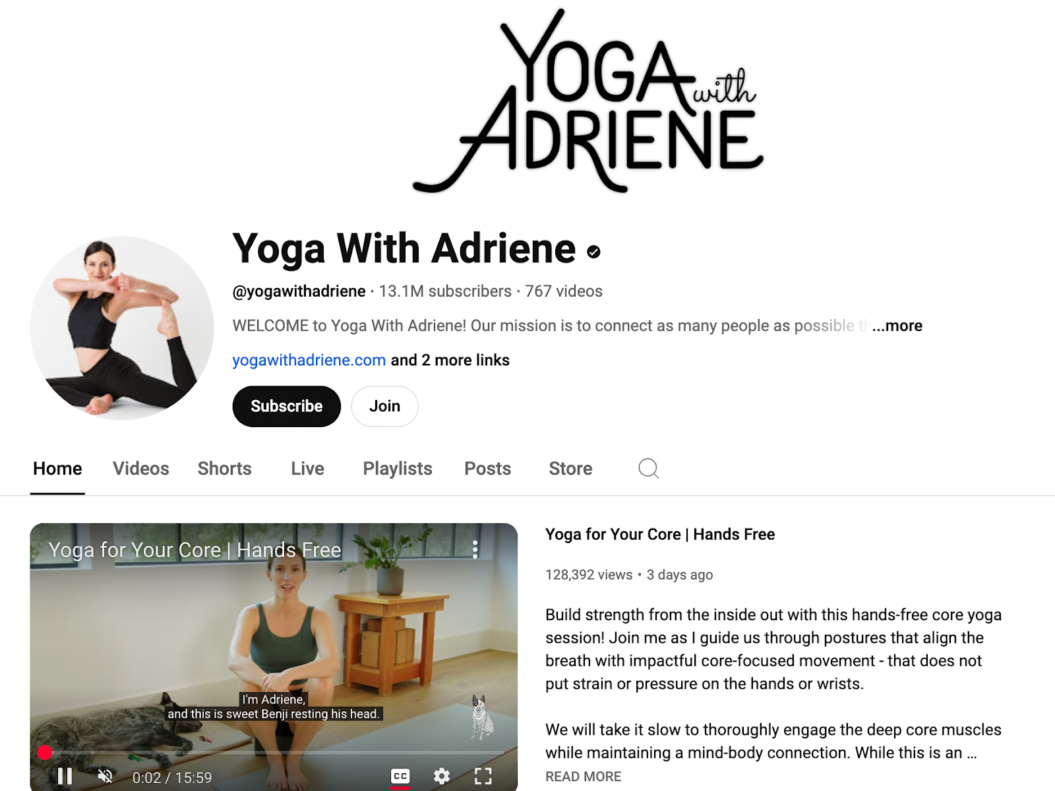
Once they had launched their app, Mishler and Sharpe had a huge audience that they could market their subscription to. You may not be a fitness influencer with 13 million subscribers, but even a few dozen is a great place to start with marketing your app.
Find media opportunities
If you can get your brand and ideas in front of more people, you’ll have a great shot at driving more sign-ups. One way you can expand your audience is to partner with people who are already talking to your ideal customers.
Can you get on a podcast to talk about how you approach fitness differently? What about a YouTube channel? Could you pitch an article to a news outlet and include a link to your website? If there are newsletters, social media accounts, or other places you might be able to earn a mention, it’s worth spending some time figuring out how to take advantage.
Hosting an online workshop is another option, and one of our recommended strategies for making money in fitness online.
Enhance the impact of your app store description
App store optimization is the practice of making sure your app’s title, descriptions, and reviews are helping people find your app.
We have an entire guide to app store optimization, and it’s a great place to start.
Emphasize community
Your marketing and the value of your content will bring users to your app. Community will keep them there and encourage them to invite their friends. (That’s one of the reasons online fitness communities are trending in 2025.)
There are many ways to build a sense of community around your fitness app, including fitness challenges, live streaming fitness classes, interacting with members, welcoming new users individually, and encouraging members to interact with each other.
The Bloom Method is a pre- and post-natal fitness app and community. Founder Brooke Cates notes that the sense of community is one of her favorite aspects of the membership. With public and private channels for member interaction, moderated discussions, and mobile scheduling, every member feels like a valued part of the Bloom family.
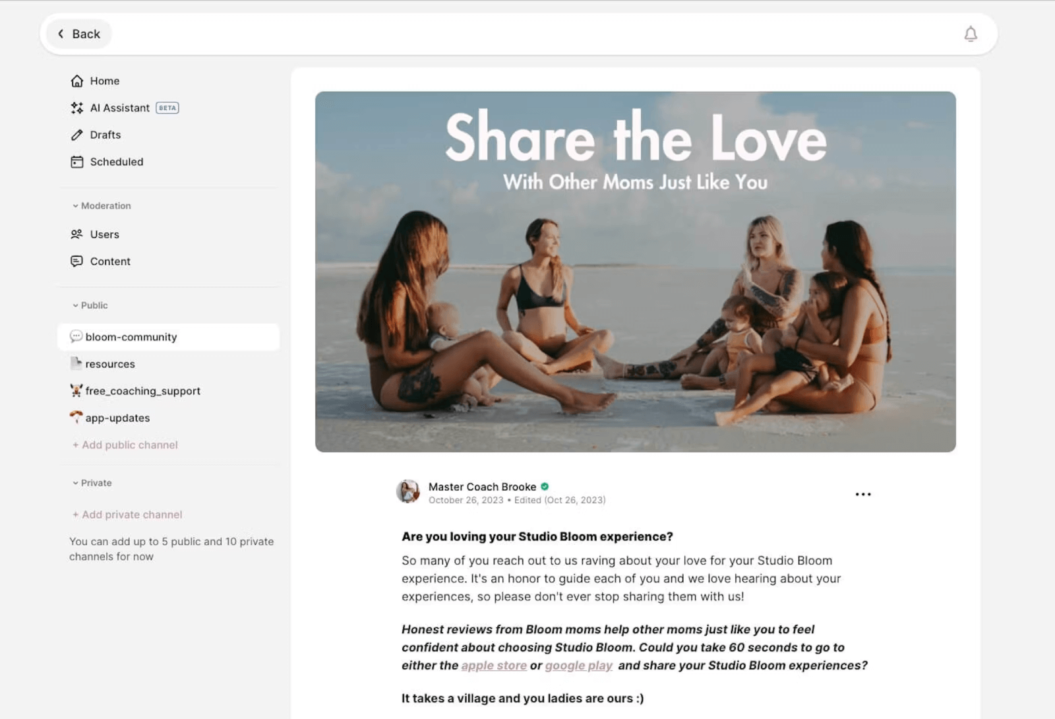
That sense of community helps The Bloom Method bring in over $1 million every year.
5 Lead Magnet Strategies That Actually Convert for Membership Owners

2025 is a great time for fitness apps
There’s a ton of demand for fitness apps in 2025 and beyond.
Popular fitness apps like MyFitnessPal, Strava, Lose It!, Peloton, and Nike Training Club are some of the most downloaded apps out there. Chances are you’ve used one of them yourself. You’ll find workout apps, nutrition trackers, and sleep trackers in the top 100 apps in the Apple App Store.
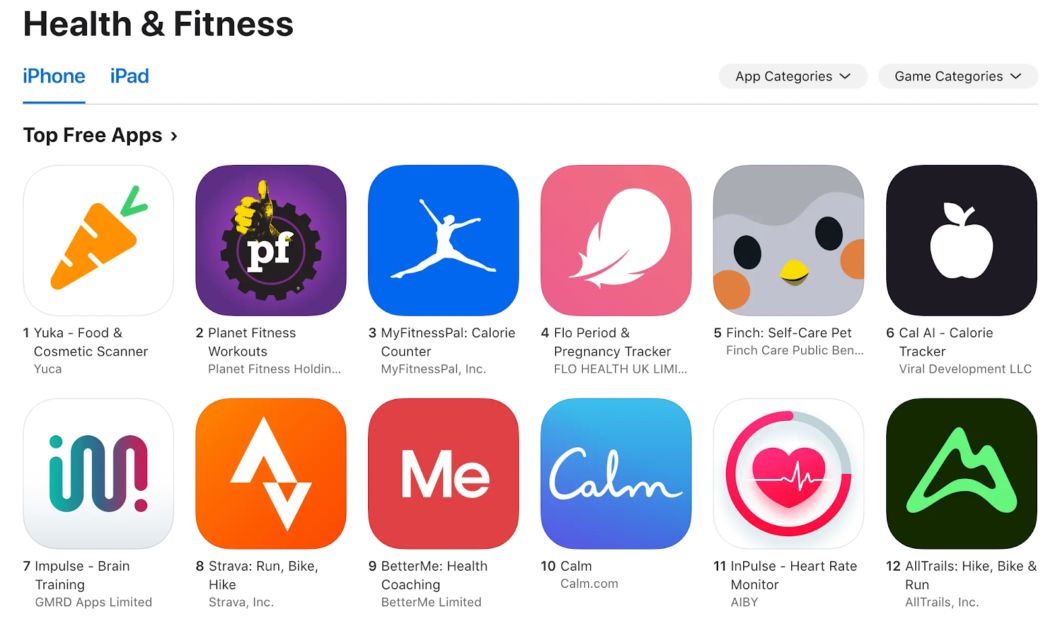
You might think that with so many big names in the market, it’s too late to launch a new app. The truth is, there’s still plenty of opportunity. With strong demand and countless ways to offer something unique, now is an ideal time to start your own fitness app.
SkyQuest projects that the global fitness app market will rise from $2.49 billion in 2024 to $9.6 billion by 2032, with Pilates playing a key role in driving that growth. And among recent creator economy statistics from Uscreen customers, the fitness category has the highest number of users and sessions. That’s a huge market you can be part of. You just need to find the right niche to focus on.
Is an app really worth it?
You might be wondering if this huge market for fitness could be better harnessed by monetizing on Instagram.
You could, but remember that social media isn’t really under your control. Search algorithms determine your reach and engagement, and you have very limited branding opportunities. Content restrictions mean you can’t just post whatever you want, plus you can run into issues, like YouTube demonetization, that make your income significantly less stable.
A large social following is important if you want to make money in fitness online, but the most successful fitness creators aren’t using it as their primary source of revenue. That comes from memberships and apps. (You certainly can build a successful online fitness business only relying on social media, but it takes a lot of work and can be a bit risky because you don’t own your audience.)
Look at MoveU, an online fitness brand that focuses on helping people solve imbalances, misalignments, and pain. They have over 1.5 million followers on Instagram:
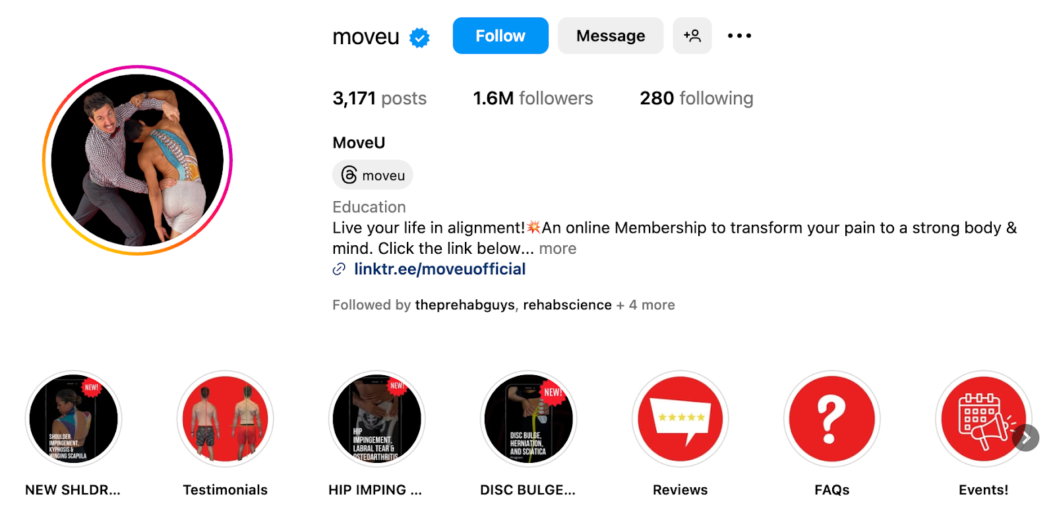
But it’s their membership site that generates stable revenue through subscriptions and keeps people coming back with an engaged community. With fitness programs, coaching, and mobile apps, users get a lot of value from MoveU’s membership site and are motivated to keep coming back.
In short, if you’re serious about building a fitness brand that’s resistant to the constant shifts of social media and has the potential to create stable revenue for you, an app is the way to go.
What makes a successful fitness app?
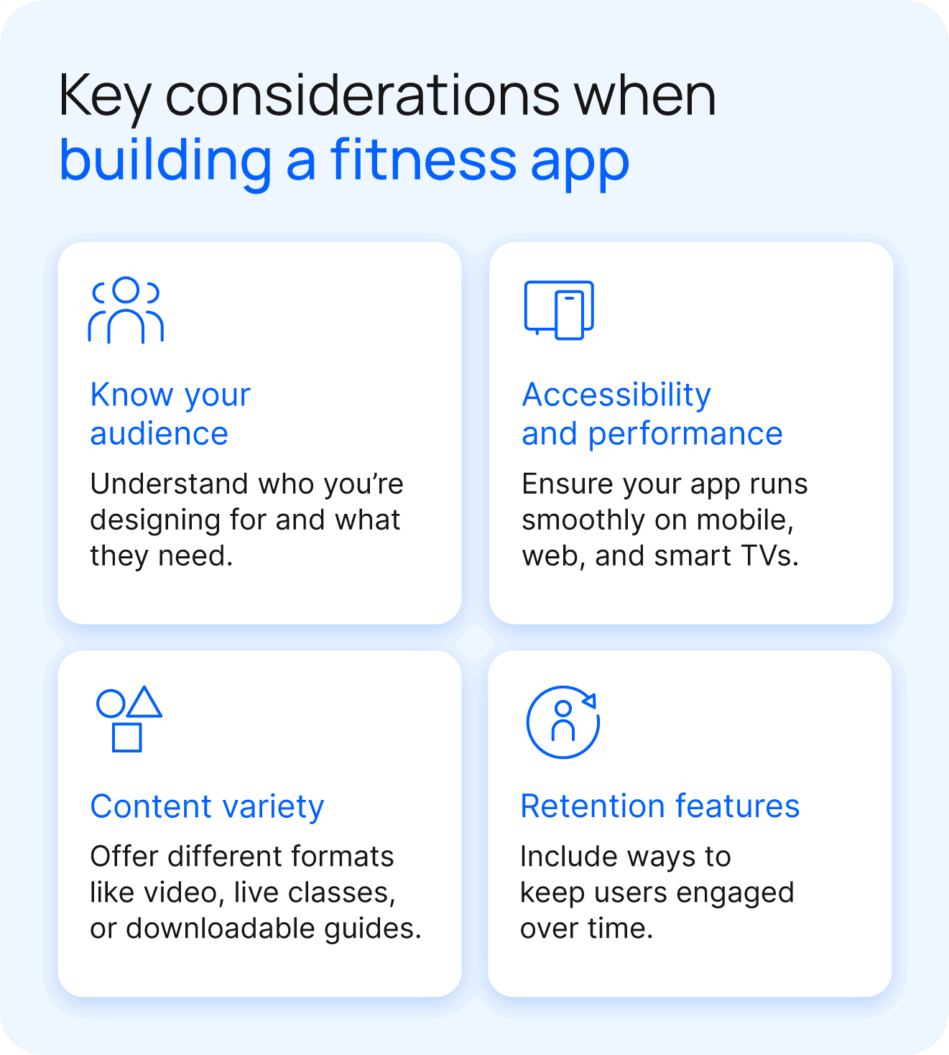
1. Great service
There are many different types of services you can provide with a fitness app. But successful apps all have something in common: They provide a great service. That’s true of nutrition trackers, health coaching apps, meditation guides, and workout programs.
The market is full of potential, though competition is fierce. You’ll need to stand out by providing value in a better way, like filming your content with the best fitness video cameras. And if your users aren’t blown away by how well your app solves their problems, they’ll find another tool.
2. Great user experience
You might have the best workouts or the most technologically advanced nutrition tracking available, but if your app isn’t easy and intuitive to use, it will fall flat. Users expect well-designed apps that are fast and easy to use.
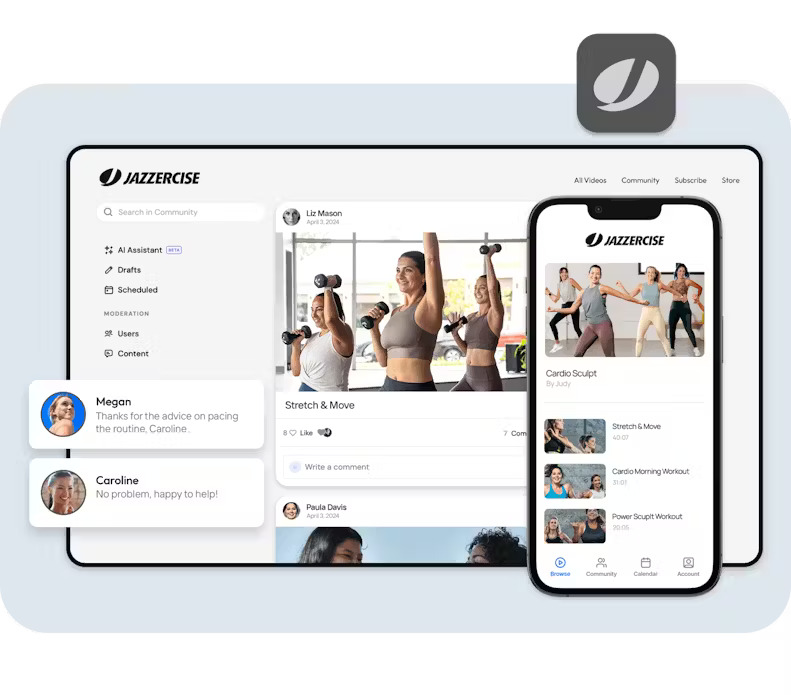
Spend time building a great user interface for your app — or, if you’re not interested in building one yourself, use a tool that provides one (we’ll discuss this option in more detail below). That’s something you’ll notice about our favorite examples of fitness OTT apps: They have fantastic user interfaces.
On a related note, make sure your users can access your video content while they’re on the go. As you can see from this data we’ve collected from our customers, most viewers are watching from apps, but there are still lots of people who want to watch from a web browser.
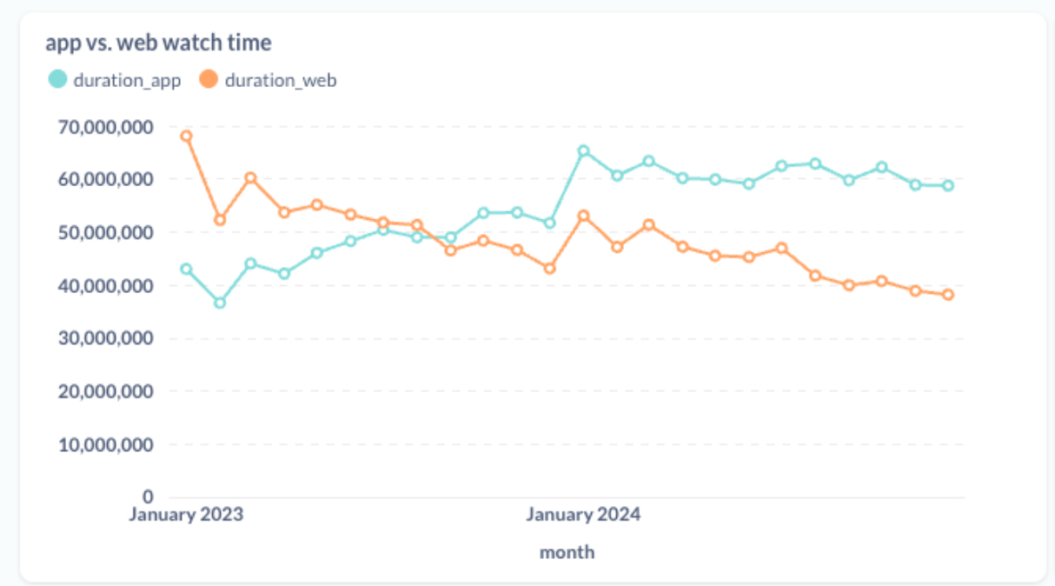
That’s why selecting the right fitness streaming platform matters — you can grow an audience through a fitness membership site first and only launch an app once your community is big enough to sustain it. Many of today’s successful fitness streaming brands have followed this approach.
3. Great marketing
If you want a lot of downloads (and paying customers), you’ll need to get your fitness app in front of the people who want it. That means marketing. If you already have an audience — if you’ve built a successful YouTube or Instagram following, for example — this part shouldn’t be too hard.
If you’re starting from scratch, you’ll need to spend more time on it. You may need to build a social media following. Or partner with someone who has an audience. Going to events, networking, or working with an already established fitness studio can also work.
No matter how big your audience is at the moment, choosing an app-building tool that includes integrated marketing solutions will make your job easier.
4. Great community
Not every fitness app starts with a built-in community, but it’s one of the things that make the best apps stand apart from the rest.
Uscreen customers who have an active community experience half the member churn compared to those without one. For those with mobile apps, up to 78% of community engagement occurs directly through the app.
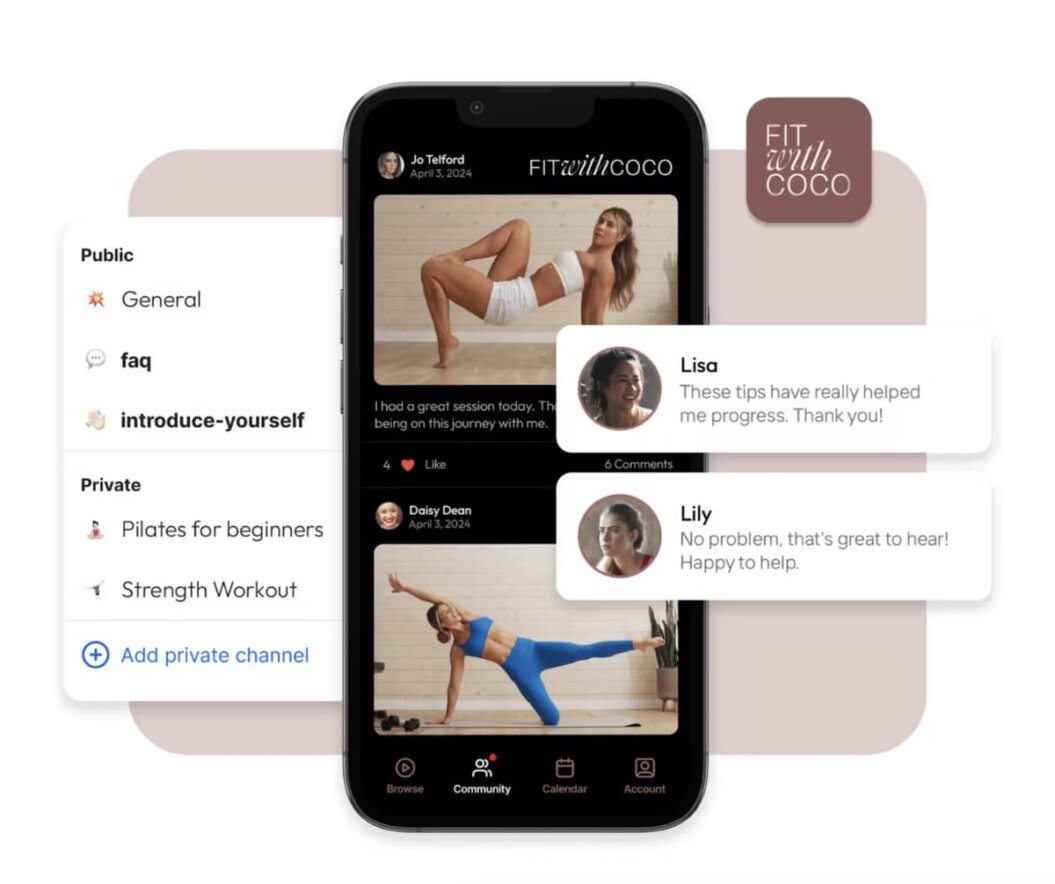
Since churn is one of the biggest threats to stable revenue, this makes a huge difference. Investing in the community around your service and app is well worth it. Luckily, once your app is up and running, there are many ways to grow and engage an online fitness community.
Get started building your fitness app today
The most important part of health and fitness app development is getting started. Taking the first step is what turns your fitness app idea into reality.
So start brainstorming. Start planning. Dream up the app that you want to share with the world. Maybe it’s a personal training app with a strong emphasis on inclusive fitness. Or a yoga streaming service. It could be something completely new that no one has thought of yet. Whatever it is, it’s yours.
And when you’re ready to bring it to life, Uscreen is here to support you. If you’re ready to start talking about how we can help you turn your dream into a reality, you can start the conversation by reading about our app-building process or checking out our on-demand demo below.
If you’re still exploring or refining your ideas, take a look at some of the successful fitness brands we’ve partnered with — their stories might spark the inspiration you need.
FAQ
Watch our quick platform demo to see how Uscreen can help you monetize your videos and grow your audience.
You don’t need coding skills to create a fitness app. No-code builders, including Bubble, Adalo, and Glide, allow you to piece together basic apps with drag-and-drop tools. However, these often require multiple integrations and extra setup.
With Uscreen, you can launch your own branded fitness app without coding, complete with video hosting, live streaming, community features, and scheduling tools in one platform.
Fitness app development costs can range between $1,000 and $50,000+, depending on the complexity of features and whether you work with freelancers, no-code platforms, or a professional development company.
One alternative is our health and wellness membership plan, priced at $799 per month, which includes:
Mobile apps plus Apple Watch support
Video hosting and live streaming
Built-in community space
Content catalog and scheduling tools
Music, notes, and downloadable resources
Integrations with tools like Zapier
Dedicated customer support
Instead of spending tens of thousands, you can launch your own feature-packed fitness app and start growing your community right away.
Fitness apps can be highly profitable when paired with the right business model. Many creators monetize through subscriptions, pay-per-view, or premium content upgrades. Success depends on user engagement, content quality, and retention.
Top options include MindInventory, Quytech, and Konstant Infosolutions for custom app development. If you prefer a faster, no-code solution, Uscreen is one of the best choices to launch a branded fitness app without large upfront costs or coding.




